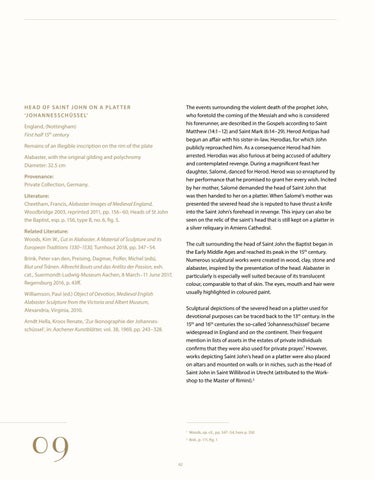H E A D O F S A I N T J O H N O N A P L AT T E R ‘J O H A N N E S S C H Ü S S E L’
The events surrounding the violent death of the prophet John, who foretold the coming of the Messiah and who is considered his forerunner, are described in the Gospels according to Saint Matthew (14:1 – 12) and Saint Mark (6:14 – 29). Herod Antipas had begun an affair with his sister-in-law, Herodias, for which John publicly reproached him. As a consequence Herod had him arrested. Herodias was also furious at being accused of adultery and contemplated revenge. During a magnificent feast her daughter, Salomé, danced for Herod. Herod was so enraptured by her performance that he promised to grant her every wish. Incited by her mother, Salomé demanded the head of Saint John that was then handed to her on a platter. When Salomé’s mother was presented the severed head she is reputed to have thrust a knife into the Saint John’s forehead in revenge. This injury can also be seen on the relic of the saint’s head that is still kept on a platter in a silver reliquary in Amiens Cathedral.
England, (Nottingham) First half 15th century Remains of an illegible inscription on the rim of the plate Alabaster, with the original gilding and polychromy Diameter: 32.5 cm Provenance: Private Collection, Germany. Literature: Cheetham, Francis, Alabaster Images of Medieval England, Woodbridge 2003, reprinted 2011, pp. 156 – 60, Heads of St John the Baptist, esp. p. 156, type B, no. 6, fig. 5. Related Literature: Woods, Kim W., Cut in Alabaster. A Material of Sculpture and its European Traditions 1330 –1530, Turnhout 2018, pp. 347 – 54.
The cult surrounding the head of Saint John the Baptist began in the Early Middle Ages and reached its peak in the 15th century. Numerous sculptural works were created in wood, clay, stone and alabaster, inspired by the presentation of the head. Alabaster in particularly is especially well suited because of its translucent colour, comparable to that of skin. The eyes, mouth and hair were usually highlighted in coloured paint.
Brink, Peter van den, Preising, Dagmar, Polfer, Michel (eds), Blut und Tränen. Albrecht Bouts und das Antlitz der Passion, exh. cat., Suermondt-Ludwig-Museum Aachen, 8 March – 11 June 2017, Regensburg 2016, p. 43ff. Williamson, Paul (ed.) Object of Devotion, Medieval English Alabaster Sculpture from the Victoria and Albert Museum, Alexandria, Virginia, 2010.
Sculptural depictions of the severed head on a platter used for devotional purposes can be traced back to the 13th century. In the 15th and 16th centuries the so-called ‘Johannesschüssel’ became widespread in England and on the continent. Their frequent mention in lists of assets in the estates of private individuals confirms that they were also used for private prayer.1 However, works depicting Saint John’s head on a platter were also placed on altars and mounted on walls or in niches, such as the Head of Saint John in Saint Willibrod in Utrecht (attributed to the Workshop to the Master of Rimini).2
Arndt Hella, Kroos Renate, ‘Zur Ikonographie der Johannesschüssel’, in: Aachener Kunstblätter, vol. 38, 1969, pp. 243 – 328.
09
62
1
Woods, op. cit., pp. 347 – 54, here p. 350
2
Ibid., p. 111, fig. 1

























